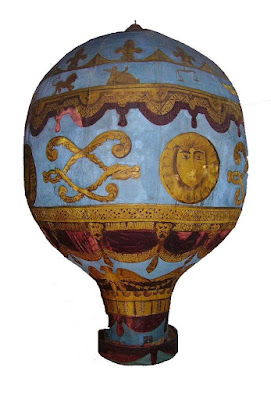 |
| Ballooning enamel patch box, c. 1790. Private Collection |
Early balloon flight from the perspective of design and celebratory crafts.
Balloon flight was a novelty in the 1780s and demonstrations attracted large crowds well into the 1800s. The first manned flight without ropes tying the balloon to the ground was on 21 November 1783 in the gardens of the Château de la Muette on the outskirts of Paris.* This was a Montgolfier balloon designed by brothers Jacques-Étienne and Joseph-Michel, who were paper makers from a lineage of paper makers and this trade served them in developing their balloon. Paper lanterns, small hot air balloons, have been made in China for over a thousand years, paper used as a lightweight material so that there was enough lift. The brothers developed a lightweight and non-flammable balloon capable of carrying people by experimenting with different combinations of paper, linen, taffeta and other silks, and varnish.**
 |
| 1786 description of the Montgolfier brothers' 1783 balloon flight. Library of Congress Collection. |
 |
| Model of the Aerostat Réveillon. Science Museum Collection. |
The balloon made for this first free flight was stained a deep blue and beautifully ornamented in gold and red with festoons hung between lion heads, eagles, the signs of the zodiac, fleurs-de-lis, suns and the monogram of the French King.*3* The exterior design of the balloon was in collaboration with friend of Montgolfier's, Jean-Baptiste Réveillon, another paper and wallpaper manufacturer who had loaned his gardens to Jacques-Étienne to build and perform initial flights of his balloon.*4* These early balloon flights were often lauded as scientific wonders and dramatic spectacles, but balloons were also beautiful hand-crafted objects.
 |
| Wallpaper, block printed on handmade paper, Jean-Baptiste Réveillon. Cooper Hewitt, Smithsonian Design Museum. |
Many other early French balloons were ornamented too, such as the Aerostat La Flesselles, the largest Montgolfier balloon launched on 19 January 1784 in Lyon, France, and Aerostat Marie-Antoinette, launched 23 June 1784 at Versailles.
 |
| Machine aerostatique de Montgolfier, launched 19 Jan 1784 (La Flesselles). Science Museum Collection. |
 |
| La Montgolfiere Marie Antoinette. Bibliothéque Nationale de France. |
 |
| Marie Antoinette balloon launched 23 June 1784 at Versailles. Gallica Collection |
A selection of other balloon prints are found here.
 |
| Bagnolet's Balloon, from Wonderful Balloon Ascents (1870).*5* |
This was the beginning of balloon mania which spread through Europe as public displays of balloon flight toured. Other balloonists designed and built their own balloons, such as the married couple Jean-Pierre and Sophie Blanchard in France, James Tytler in Scotland, and James Sadler in England, as well as many others. Fascination about ballooning bled into popular culture with the production of prints, balloon inspired fashions with puffed out sleeves and pantaloons, and 'balloon coaches' which were the fastest horse-drawn carriages renamed in honour of the new aerial phenomenon (see here). A variety of material things were also produced, including enamelled boxes, fans, pottery and porcelain and other decorative objects, all inspired by humanity's first endeavours to take to the skies.
Gallery
 |
| Cloak peg celebrating the flight of the Lunardi balloon, c. 1785.*6* Probably made in Bilston or Birmingham. Science Museum Collection |
The Italian Vincenzo Lunardi made his balloon flight on 15 September 1784 at the Artillery Ground of the Honourable Artillery Company in London.
 |
| Cloak pegs celebrating the flight of the Blanchard balloon, c. 1785. Private collection. |
* Arthur F. Scott, 'The Invention of the Balloon and the Birth of Modern Chemistry', Scientific American, 250 (1984) 126-137 (p. 126).
** Fulgence Marion, Wonderful Balloon Ascents (New York: Scribner, Armstrong & Company, 1874).
*3* Marion, p. 56.
*4* Leonard N. Rosenband, 'Jean-Baptiste Réveillon: A Man on the Make in Old Regime France', French Historical Studies, 20 (1997), 481-510 (p. 495).



